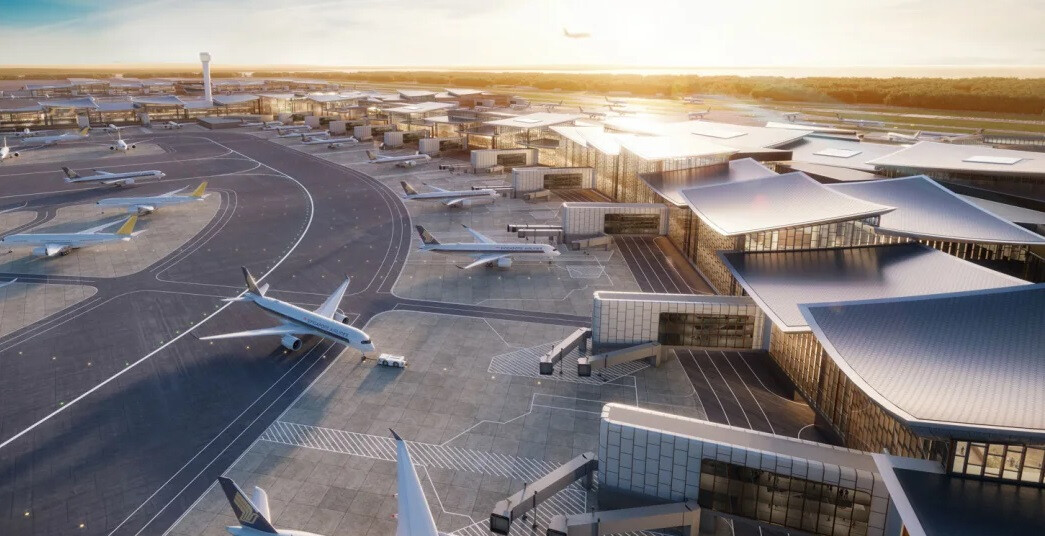
Singapore Changi International Airport, having swept prestigious awards in the aviation industry and been named the 'World's Best Airport' for 2025, has embarked on further expansion of its national pride, Changi Airport. On May 14th, under the leadership of Prime Minister Lee Hsien Loong, the official groundbreaking ceremony for Terminal 5 (T5) was held, marking the commencement of a large-scale project aimed at opening in the mid-2030s.
Singapore, a city-state with a population of six million, has strategically concentrated its commercial aviation resources on a single airport, Changi. Unlike most airports worldwide that operate separate domestic and international terminals, all flights at Changi Airport are international. This unique feature offers passengers the advantage of freely moving throughout all public areas of the airport.
Yam Kum Weng, CEO of Changi Airport Group, described the planned Terminal 5 as a "mega yet cozy" space, emphasizing that it will deliver a "personalized, stress-free, and positively surprising airport experience."
The Terminal 5 project, with a total investment of S$10 billion (approximately ₩9.8 trillion), was initially announced in 2013 and slated for commencement in 2020 but was delayed due to the COVID-19 pandemic. However, the pandemic did not merely affect the timeline of the T5 project. Additional pandemic preparedness and safety measures have been incorporated into the new terminal's design.
The new building will feature an advanced ventilation system that can be activated in the event of a pandemic. Furthermore, in line with Changi Airport's ongoing 'document-free' airport strategy, all passengers will utilize contactless entry and exit systems based solely on biometric recognition. The layered leaf-like roof design will not only facilitate air circulation but also allow the terminal to be divided into multiple mini-terminals if necessary for passenger segregation or rapid disease screening.
Upon completion, Terminal 5 will become the primary hub terminal for Singapore Airlines and its low-cost carrier, Scoot. Currently, these two airlines operate across various terminals at Changi Airport. T5 is designed to handle 50 million passengers annually, approximately half of Changi Airport's current total capacity.
Beyond an Airport: Changi Airport's Appeal as a Tourist Destination
One of the reasons Changi Airport receives global acclaim is the diverse range of activities and tourist facilities located within its premises. These include themed gardens such as the Butterfly Garden, Cactus Garden, Water Lily Garden, Sunflower Garden, and Orchid Garden, as well as children's play areas, a large slide, a rooftop swimming pool, and movie theaters.
A recent highlight is Jewel Changi Airport, a 10-story luxury shopping mall. Completed in 2019, its centerpiece is the Rain Vortex, the world's tallest indoor waterfall, which is open to both travelers and the general public, establishing itself as a new landmark in Singapore. Jewel Changi Airport offers a unique experience that blends nature, art, and technology beyond mere shopping, further enhancing Changi Airport's appeal.
Leaping Towards the Future: AI-Assisted Systems and Autonomous Baggage Handling
Trent Tesch, Principal at architectural firm Kohn Pedersen Fox (KPF), which is collaborating on the design of Terminal 5, emphasized that "efficiency and experience are not mutually exclusive concepts." He explained, "Too often, airports are designed as mere machines for movement—efficient but impersonal, treating passengers as mere numbers within a system. Instead, T5 is envisioned as a vibrant mini-city embodying Singapore's unique richness, layered design, and deep humanity."
Located near the equator, Singapore experiences a hot and humid tropical climate. T5 has been designed with these conditions in mind. A massive rooftop solar photovoltaic system is expected to generate not only the electricity needed for airport operations but also enough power to supply approximately 20,000 four-room apartments annually. This is considered a significant step towards sustainable airport operations.
Last year, Changi Airport handled over 68 million passengers, the fourth-highest number globally. Flights departing from Singapore offer direct connections to 170 cities worldwide. To efficiently manage this overwhelming traffic and prepare for future demand, T5 will incorporate various artificial intelligence (AI)-based advanced technologies. These include AI-powered guidance robots, autonomous baggage handling systems, and predictive analytics for congestion management. It is anticipated that these technologies will provide passengers with an even faster, more convenient, and safer airport experience.
Changi Airport's continuous innovation and expansion demonstrate Singapore's ambitious vision to further solidify its position as a global aviation hub. Not resting on its laurels as the world's best airport, Changi Airport's ongoing investment and development are attracting global attention. The successful construction and operation of Terminal 5 are also expected to contribute significantly to Singapore's economic growth.
[Copyright (c) Global Economic Times. All Rights Reserved.]



























